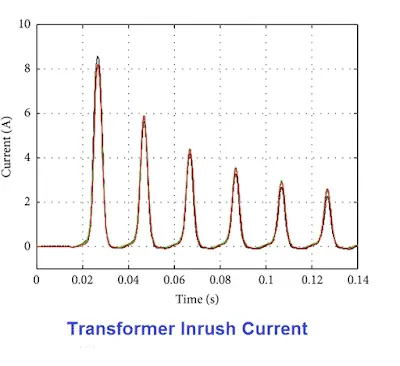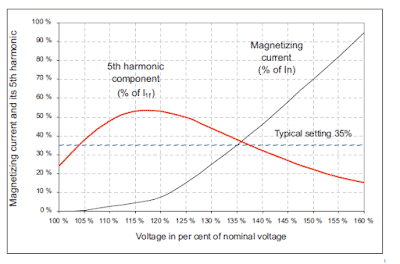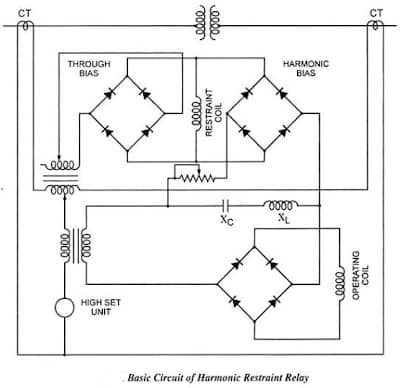The differential relay is used for the protection of the transformer, alternator, and large-rating HT motor. The differential protection scheme is also known as zone protection. The relay must trip in case of a fault in the winding of the transformer. If the fault is outside the zone, the differential relay must remain inoperative.
The transformer draws a large current at the time of switching on of the transformer at no load. The large current drawn by the transformer is known as the inrush current or magnetizing inrush current; the magnitude of the inrush current maybe 8 to 10 times or even larger than this. The magnitude and duration of the inrush current depend on the instant of the AC waveform at which the transformer is switched on. The waveform of the transformer inrush current is given below.

The secondary current is zero, and the primary current is high at the time of the transformer’s charging. This difference in current between primary and secondary may lead to the operation of a differential protection relay. Thus, it is not possible to charge the transformer. If the protection relay is bypassed, the differential protection of the transformer will be defeated. Bypassing the differential protection relay is not the solution.
The transformer generates a 2nd- and 5th-order harmonic current at the time of charging because of the nonlinear B-H characteristics of magnetic flux. The magnetic flux in the core is not sinusoidal, and the transformer generates harmonics. The sensing of the harmonics and restraining the differential protection relay operation at the time of the transformer’s charging is one of the solutions. This requirement is fulfilled by harmonic restraining in the differential protection of the transformer.
If we analyze the magnetizing inrush current by the Fourier series, it has 2nd and 5th-order harmonics. The 2nd order harmonic is rich when the transformer draws magnetizing current at the time of switching of the transformer. The frequency of the 2nd order harmonics is 100 Hz. The differential relay has a 100 Hz filter circuit, which measures the frequency and the magnitude of the 2nd-order harmonic current in the differential current.
If the relay senses the current of 100 Hz frequency and if the current is more than the differential current setting of the relay, the relay will observe that the transformer is taking the inrush magnetizing current. The relay blocks its main tripping mechanism. Therefore, the 2nd-order harmonic current needs to be blocked in the differential relay because the 2nd-order harmonic current will operate under no fault within the transformer.
Thus, the harmonic current blocking is an important feature of the differential protection relay. In the harmonic restraint differential protection scheme, the harmonic restraint differential relay has the 2nd,3rd, and 5th order harmonic blocking circuit and the differential protection circuits.
If the inrush current contains a predominant 2nd-order harmonic current, it is a symptom of transformer energization, and differential protection is supposed to be blocked during normal transformer energization. If the ratio of the second harmonic current to the fundamental is greater than the 2nd-order harmonic current set point, the relay blocks the differential operation because it sees this condition as transformer energization.
The magnitude of 2nd order harmonic current in inrush current depends on transformer material, construction, and remanence. Therefore, the setting of the 2nd-order harmonic blocking current can not be calculated in a straightforward way. The relay measures the ratio of the 2nd-order harmonic current and the fundamental current, and the setting of the 2nd-order harmonic blocking current can be done accordingly.
The setting of the 2nd order harmonic restraining is generally kept between 20-25 % of the differential relay setting. If the current is below the differential relay setting, the relay does not trip because the relay will observe it as a transformer charging phenomenon. If the harmonic restraining current is more than the differential relay setting, the relay will trip with the differential protection fault.
During the over-fluxing of the transformer, the transformer current has a predominant 5th-order harmonic current. The over-fluxing happens when there is a sudden rise in voltage or a sudden drop in the frequency. The measurement of 5th-order harmonic current is very important for over-excitation monitoring of the transformer. The magnitude of the 5th-order harmonic current under over-excitation depends on the magnetization curve of the transformer.
The differential protection relay will trip in case of over-fluxing. If the over-fluxing happens for a short period of time, the differential relay should not trip. Therefore, to prevent the operation of differential protection relay in case of over fluxing, 5th order harmonic restraining is provided. The 5th-order harmonic current varies as the voltage applied to the transformer increases from its rated voltage.

If the magnitude of the 5th-order harmonic current is more than the setting of the differential protection relay setting, the relay will trip. If the magnitude of the 5th-order harmonic current is less than the setting of the differential protection relay setting, the relay will not trip. The setting of the 5th-order harmonic restraining is generally kept between 20- 25 % of the differential relay setting.
The operation of the transformer is not possible without having the harmonic restraint in differential protection.
The basic circuit of the harmonic restraint relay is given below.

The harmonic restraining elements of the relay measure the magnitude of the harmonic current, and tripping of the relay is restrained if the harmonic current is well below the specified current.
“If the transformer has been out of use for some time (i.e. after storage) its remanence may be very small, causing the 2nd harmonic blocking not to operate at the first energizing attempt. Therefore, the setting could be lowered to 10% for the first energizing attempt.”